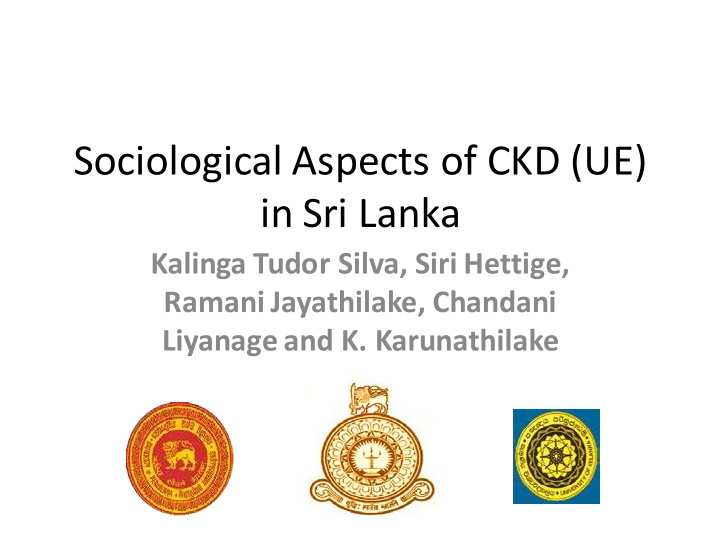



Sociological Aspects of CKD (UE) in Sri Lanka Kalinga Tudor Silva, Siri Hettige, Ramani Jayathilake, Chandani Liyanage and K. Karunathilake
Outline 1. CKD as a Development-induced Disease 2. Social Epidemiology of the Disease 3. Stigmatization of CKD (UE) 4. Coping Strategies 5. CKD Activism 6. Possible Remedies
CKD as a development induced disease • Mostly reported in newly developed areas or dry zone populations undergoing rapid change – New settlement areas like Padaviya, Madirigiriya and Giradurukotte – “border villages” affected by war -induced population movements • Related to adoption of green revolution technology in rural agriculture from 1960s – heavy use of chemical fertilizer – Overuse of chemical pesticides and weedicides • Parallel changes in ecosystems, society, livelihoods and lifestyle • Many of the reported agents of the disease such as arsenic, cadmium and lead may be seen as products of environmental change • Irrigation systems – small tank cascades systems – areas with high density of agro-wells – tail end of large scale irrigation systems like Mahaweli system
CKD as Development-induced
Socio-economic changes • Increased social and economic polarization • Emergence of a layer of farm/off-farm workers who are mobile • Increased indebtedness of small farmers • Opportunities and risks associated with military employment • Changes in family structures and relations
CKD ss a potential cause of poverty and underdevelopment • Increased impoverishment of affected families • Often the patient is the main breadwinner of the household • Impacts – Loss of livelihood – Loss of productivity – Cost of treatment • Some families move from affected new settlement areas such as Padviya to areas outside the epidemic zone • As a new challenge for the health sector
Social Epidemiology • All single cause explanations problematic • Even if we say arsenic, cadmium, fluoride or algae, agrochemicals or a combination of them are causative agents we need to explain the specifics in the social epidemiology of the disease. • Differential exposure to these risk factors according to socio- economic status must be explored. • Factors like drinking water, food consumption, environmental changes and direct exposure to agrochemicals are common to all residents in an area and, therefore, cannot explain observed differences in disease prevalence • Folk beliefs: natural spring water gives them protection (Gonamapiryawa)
Gender profile of CKD patients • Early hospital data indicated a greater prevalence among males (70% vs 30%). CKDue patients more likely to be male as compared to females (OR 1.9). • Community studies by Liyanage and Jayathilaka also point to a similar gender profile. • WHO study ,which examined a randomly drawn large population sample, found a higher prevalence among females (16.8%) compared to males (13.3%). • A sample bias or a change in the epidemiology of the disease?
How do we explain a reported higher prevalence among males if that is indeed the case? • Males and females live in the same physical environment so that they share the same sources of drinking water and same food. • Greater male involvement in risk behaviors such as application of agrochemicals without using protective gear • Gender-based differences in lifestyle in matters such as alcohol use, smoking and consumption
Coping Strategies • Moral panic about the disease • Cost of medicines • Impact on livelihoods and living standards (sale and mortgage of assets) • Availability and accessibility of services including dialysis, renal transplantation • Fund raising from sympathizers • Appeals for kidney donations – Most donations from within the family or by voluntary donors such as Buddhist monks – Newspaper appeals (“Save life of so and so”) – Ethical issues – Legal regulation
Appeals for Kidney Donations
Stigmatization of CKD • View that members of some families are genetically vulnerable as more than one member of the same family had contracted the disease • Labelling process. – pipihaluwa in Madawachchiya and Pitapanduwa in Padaviya (Dr. Chandani Liyanage’s research) – “ wakugadu Karayo ”, “Waku gadu set eka ”, Waku gadu gansiya ” (Prof. Ramani Jayathilaka’s research). • Near certainty of death • Identified as a family catastrophe (Prof. K. Karunathilake’s research) and a karmic disease (karuma ledak/vindavanava) • It was difficult for young men and women in such families to secure marriage partners • Denial of the disease
CKD Activism • Currently driven mostly by committed doctors and health workers • Need for empowering, organizing and networking CKD patients and their families • Need for social services and assistance for affected families • Pressure for remedial action at various levels
Other social issues requiring further research • Clearer understanding of gender and age differential in CKD morbidity • Ethnic and genetic differences in morbidity, exposure and vulnerability • Occupational differences in morbidity; different population categories in farming populations, owner- farmers vs wage labourers • Which specific forms of development drive the epidemic? • GIS type analysis of regional differences in CKD prevalence • The role of religion in coping with the disease
Conclusion • Need to move away from a single cause explanations to multi-causal explanations • Apart from being in important cause of morbidity and mortality in selected farming areas, CKD can be a major obstacle to the ongoing strategy of development • Need to identify and disseminate methods of prevention
Recommendations • Rethink about development strategies incl. fertilizer subsidy • Changes in farming systems and promotion of organic farming • Improved regulatory framework for distribution and application of agrochemicals – Safeguards in agrochemical application • Improved procedure for checking heavy metel content in agrochemicals • Improved drinking water supply • Educate the public about hazards of overuse of agrochemicals
Recommendations, Cont. • Collaborative Research – Any genetic differences in vulnerability and exposure? • Special Social Science Unit in the Ministry of Health • Role for civil society organizations to network, educate and assist the patients and their families
Recommend
More recommend